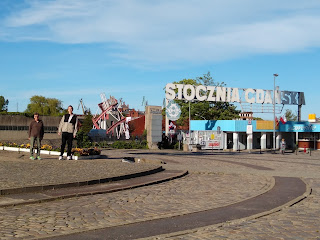Our plan this year was to spend 3 or 4 days in Yoho National Park in early October for some hiking and gentle mountaineering. An e-mail received in late August had us going in a new direction. Cathedral Lakes Lodge was having a sale, 3 nights for the price of 2. We have ventured into Cathedral Lakes Provincial Park on three other occasions so didn't hesitate to change our plans. The hiking is out of this world
.
This awesome park is located in the mountains 80 kilometres south west of Penticton. Access to the park is by one of 3 different hiking trails between 16 and 26 kilometres long and with elevation changes of between 1100 and 1700 metres or if you have a reservation at the lodge, a chauffeur driven ride up a scarey mountain road.
Our previous trips have always been in the spring when the weather can be a bit iffy.
On those trips, we have experienced lightning storms, snow storms, torrential rain and sunshine, sometimes all on the same day.
But no matter how nasty it got, the weather always seemed to break at just the right moment for that perfect photo op. Please note, that I crawled out to the edge for this shot, stood up long enough to take the photo then immediately dropped back to my knees to crawl back from the edge.
My fear of heights was awoken in the Cathedrals.

When we booked it was with the hope that the weather would be a bit more stable as we were traveling in the fall. We left Penticton in a torrential downpour. The rainy drive to the lodge's base camp required a paved 60 kilometre highway ride to the town of Keremeous, where we crossed over to the south side of the Similkameen River using the newly repaired red bridge.
Photo: ourbc.com
Once over the bridge we had a 20 kilometre gravel road to the base camp where we would meet up with our ride up to the lodge.
The rain stopped as we arrived to the entrance of the Park. Perhaps an omen of good things to come.
Our ride up the mountain was in a fairly new 4x4. We loaded our gear for a comfortable and decadent ride up the mountain.
On previous trips, our rides have been in a unimog truck. It is as uncomfortable to ride in as it is ugly to look at.
Photo: naturalplacesphotography.com
The rain started again as we powered up the mountain.
Just as we arrived to the lodge the rain fall had turned to snow fall and we were greeted by a winter wonderland.
The park had not let us down. The weather was going to be as iffy as ever.
Our stay in the lodge included all meals, so a snowy hike around Quiniscoe Lake seemed like a good way to get our appetite in working order.
The hike was made a good deal trickier when even a small incline took some fancy footwork to stay on our feet.
At our age, not wanting to risk a hip, our 30 minute stroll around the lake became a 60 minute shuffle.

But the photo ops were still pretty good despite the falling snow.
A good end to our day with the hopes and dreams of a less iffy day tomorrow.
But iffy it was. Our plan today was to scale Quiniscoe Mountain, seen in the background.
We awoke to find it blanketed in a thick, dark, ugly looking clouds. The forecast said it would probably remain socked in for the day. Time for Plan B.
There are no lack of great hikes in the Park.
So we are off to Lady Slipper Lake. As we climbed, things were starting to warm up making the trail less treacherous as the snow melted away.
It has been at least 20 years since we last visited Lady Slipper.
It is still as beautiful as it was then.
However, I'm a little older, have a little less hair and my beard could give Santa a run for his money.
Okay, and perhaps I have a few extra pounds as well.
The weather improved with the snow melting away faster than an ice cream cone on a hot Penticton (smoke free) summer day.
Things were looking up for tomorrow, our last chance to summit Quiniscoe Mountain.
We woke to a clear view of Quiniscoe Mountain with nary a cloud marring it's snow capped peak.
Quiniscoe Mountain reaches an altitude of 8,369 feet.
Since we had done the first 6,561 feet by 4x4, this would leave us with another 1,808 feet to hike.
The first 1,000 feet was a pleasure but then it became a bit of a scramble over a field of boulders.
As we clawed our way up to the summit, nasty dark clouds started to roll from the wet (SP) coast and they arrived with a big helping of wet sloppy snow.
Let the "iffy" begin.
The final climb to the summit was slow as the thick fog and fresh snow cover were making it difficult to find the rock cairns that marked the trail.
Rule 1 in the Cathedral's is always know where you next cairn is before you move on. But as in the past, the iffy weather broke and the snow stopped just as Nonie reached another summit and another great photo.
As we returned to the lodge, the weather just got better and better and better.
Photo ops as well.
Our successful day made our hot tub session especially sweet.
It was another great sojourn to Cathedral.
It's always nice when things from your past can be revisited and you find that they have managed to remain the same. Iffy weather and all.

























































